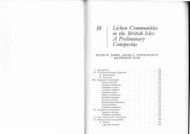Create successful ePaper yourself
Turn your PDF publications into a flip-book with our unique Google optimized e-Paper software.
on young trees, on very humid cool in part also<br />
late occurring frost occurring habitats, oceanic in<br />
reference to the moisture conditions, r.acidoph.,<br />
m.photoph., anitroph., usually only with<br />
Hypogymnia phys. – mieur-subatl-med, oc –<br />
v.rare (0); süSch (Schramberg), Ju (Schörzingen,<br />
Ehingen), Ne (Trillfingen), Do-Av (repeatedly)<br />
LIT.: PURVIS ET AL. 1992, SANTESSON 1952<br />
Calicium Pers.<br />
Introduction<br />
The genus Calicium numbers only the group <strong>of</strong><br />
coniocarpic or dust fruited lichens (goblet<br />
lichens). As fir the characterization <strong>of</strong> this<br />
group, disintegration <strong>of</strong> the asci when ripe into<br />
fragments and producing together with the spores<br />
a dust-like mass covering the upper side <strong>of</strong> the<br />
apothecium (Mazaedium). The fruiting bodies<br />
are, as a rule, clearly stalked and end with a<br />
clavate to egg-form “capitulum” and have<br />
thereby a certain similarity to a short needle.<br />
The thallus <strong>of</strong> the Calicium species is found in<br />
the interior <strong>of</strong> the substrate or is developed as a<br />
definite crust and is colored gray to green or pale<br />
yellowish, the mazaedium is black, the capitulum<br />
is <strong>of</strong>ten brown on the exterior and white or<br />
yellow-green pruinose. The spores are twocelled,<br />
dark brown.<br />
Of the 25 species distributed mainly in the<br />
cool-temperate zones <strong>of</strong> the earth, 10 occur in<br />
Germany. They occur on rain-sheltered, humid<br />
habitats, above all on bark (in bark cracks) <strong>of</strong><br />
older deciduous and conifers and on wood, only<br />
one species (C. corynellum) lives on overhanging<br />
silicate rocks. C. adspersum is found<br />
almost exclusively on old oaks in oak-hornbeam<br />
forests in slightly continental influenced sites, C.<br />
viride occurs mainly on conifers in the<br />
mountains. C. abietinum, C. adspersum, C.<br />
quercinum and C. corynellum are species <strong>of</strong> the<br />
central European summer-green deciduous<br />
forested region; reaching in the north<br />
approximately to the distribution boundary <strong>of</strong><br />
Quercus robur or extending only a trifle farther.<br />
C. lichenoides, C. viride, C. trabinellum and C.<br />
glaucellum are distributed in the boreal conifer<br />
forest region and in central Europe (here<br />
occurring in the mountains). The most <strong>of</strong> the<br />
indigenous Calicium species also occur in the<br />
mediterranean region, <strong>of</strong>ten – above all the<br />
boreal species – more in the mountains. Often<br />
avoiding the atlantic regions.<br />
Genus Characteristics and Determination<br />
Thallus crustose, in the substrate or clearly<br />
developed, granular, warty to appearing<br />
squamulose, gray, gray-green, yellowish, or<br />
green, with Trebouxia. Ap. definitely stalked,<br />
rarely short stalked to sessile, with ± spherical to<br />
lens-form capitula, margined, black, but on the<br />
capitulum underside and the margin sometimes<br />
whitish, brown or yellowish pruinose, with black,<br />
sometimes pruinose mazaedium. Exc. clearly<br />
developed. Paraphyses branched. Asci cylindric<br />
to clavate, early disintegrating and with the<br />
spores producing a mazaedium. Sp. 2-celled,<br />
dark brown, thick walled, <strong>of</strong>ten with<br />
characteristic ornamentation. Pycnosp. short<br />
cylindric to broadly ellipsoidal. Ch: above all<br />
Pulvinic acid derivatives, Norstictic acid etc.<br />
Keying caution: The ap. height is measured excluding the<br />
stalk. Sp. measurement is on ripe spores. Unripe spores are<br />
<strong>of</strong>ten smaller. Ornamentation is only clearly recognized at<br />
higher magnification (oil immersion); treatment with K<br />
facilitates the study <strong>of</strong> structure.<br />
1 On silicate rock. Thallus light yellow to<br />
greenish, finely mealy, parasitising whitish to<br />
beige crusts (Haematomma ochr.). Ap. short<br />
stalked to almost sessile, capitulum -0.7 (1.5) mm<br />
wide. Sp. dark brown, 12-16 x 4-6 µm. R-,<br />
Rhizocarpic acid . C. corynellum<br />
(if ap. stalked, sp. 6.5-8 x 2.3-3 µm, spiral ribbed:<br />
. Microcalicium arenarium)<br />
1* On bark and wood 2<br />
2 Ap. sessile . 3<br />
2* Ap. clearly stalked . 4<br />
3 Ap. yellow to greenish-yellow pruinose. Sp. 5.5-<br />
6.5 µm thick . C. adspersum (5)<br />
3* Ap. not yellow pruinose. Sp. 3-4 µm thick .<br />
Microcalicium subpedicellatum<br />
4 Ap. capitulum yellow (-greenish) pruinose<br />
(contains Vulpinic acid when ripe). Ap. -1 mm<br />
high . 5<br />
4* Ap. capitulum not yellow (-greenish) pruinose . 6<br />
5 Thallus usually clearly developed, warty to<br />
almost squamulose-scurfy, gray to<br />
yellowish-gray, K+ red, P+ yellow, then red. Ap.<br />
<strong>of</strong>ten only short stalked, even almost sessile.<br />
Capitulum broad, -0.8 (1.1) mm, yellowish<br />
pruinose at the margin and on the mazaedium<br />
(“disk”). Sp. 13-16 x 5.5-6.5 µm, clearly<br />
122





